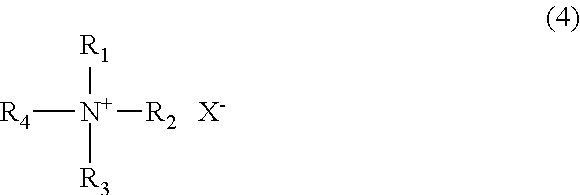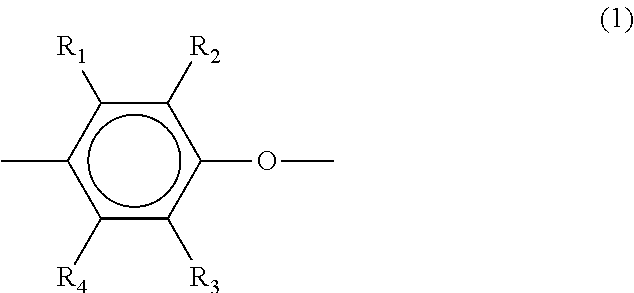Method for producing polyphenylene ether
a technology of polyphenylene ether and polyphenylene ether, which is applied in the field of new methods, can solve the problems that the metal salt as a polymerization catalyst component cannot be completely separated from the polyphenylene ether in some cases, and the mechanical properties of the obtained polyphenylene ether are not good, and achieve excellent mechanical properties
- Summary
- Abstract
- Description
- Claims
- Application Information
AI Technical Summary
Benefits of technology
Problems solved by technology
Method used
Image
Examples
example 1
[0145]A polymerization solution constituted of 1.26 kg of 2,6-dimethylphenol, 5.74 kg of toluene, a prescribed amount set in the above-mentioned common procedures of a catalyst (C), and 250 mg of an ion catalyst (D) was prepared; introduced in a reactor; a control valve downstream of a reflux cooler was regulated; the liquid temperature was regulated to 40° C.; the polymerization solution was introduced in a reactor; a control valve downstream of a reflux cooler was regulated; the liquid temperature was regulated to 40° C.; and an oxygen-containing gas was passed from a sparger, thus oxidatively polymerizing 2,6-dimethylphenol. An aqueous solution of EDTA tetrasodium salt was mixed into the polymerization solution 150 min after the start of the oxidative polymerization, and stirred for 10 min and the oxidative polymerization was terminated. At this time, a part of the polymerization solution was taken out to sample a polyphenylene ether (after the polymerization termination). Therea...
example 2
[0149]A polymerization solution constituted of 1.26 kg of 2,6-dimethylphenol, 5.74 kg of toluene, a prescribed amount set in the above-mentioned common procedures of a catalyst (C), and 150 mg of an ion catalyst (D) was prepared, and the same procedures as in Example 1 were carried out to obtain a polyphenylene ether (after the polymerization termination) and a polyphenylene ether (after the quinone-coupling treatment). There occurred no bubbling in the interface between an organic phase and a water phase when the phases were separated, and thus the phases were easily separated. The ηsp / c was measured as in Example 1. A polyphenylene ether composition was prepared as in Example 1, and measured for the Izod impact strength, the retention ratio of chemical resistance and the color tone.
[0150]The measurement results are shown collectively in Table 1.
example 3
[0160]A polymerization solution constituted of 1.47 kg of 2,6-dimethylphenol, 5.53 kg of toluene, an amount 1.17 times a prescribed amount set in the above-mentioned common procedures of a catalyst (C), and 250 mg of an ion catalyst (D) was prepared, and the same procedures as in Example 1 were carried out to obtain a polyphenylene ether (after the polymerization termination) and a polyphenylene ether (after the quinone-coupling treatment). When an organic phase and a water phase were separated, there occurred no bubbling in the interface between the phases, and thus the phases were easily separated. The ηsp / c was measured as in Example 1. A polyphenylene ether composition was prepared as in Example 1, and measured for the Izod impact strength, the retention ratio of chemical resistance and the color tone.
[0161]The measurement results are shown collectively in Table 1.
PUM
| Property | Measurement | Unit |
|---|---|---|
| absolute pressure | aaaaa | aaaaa |
| absolute pressure | aaaaa | aaaaa |
| partial pressure | aaaaa | aaaaa |
Abstract
Description
Claims
Application Information
 Login to View More
Login to View More - R&D
- Intellectual Property
- Life Sciences
- Materials
- Tech Scout
- Unparalleled Data Quality
- Higher Quality Content
- 60% Fewer Hallucinations
Browse by: Latest US Patents, China's latest patents, Technical Efficacy Thesaurus, Application Domain, Technology Topic, Popular Technical Reports.
© 2025 PatSnap. All rights reserved.Legal|Privacy policy|Modern Slavery Act Transparency Statement|Sitemap|About US| Contact US: help@patsnap.com



